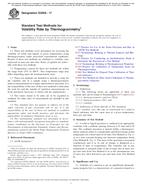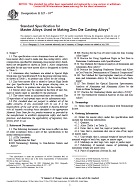1.1 This guide covers a systematic approach to the development, testing, evaluation, and documentation of ground-water modeling codes. The procedures presented constitute the quality assurance framework for a ground-water modeling code. They include code review, testing, and evaluation using quantitative and qualitative measures. This guide applies to both the initial development and the subsequent maintenance and updating of ground-water modeling codes.
1.2 When the development of a ground-water modeling code is initiated, procedures are formulated to ensure that the final product conforms with the design objectives and specifications and that it correctly performs the incorporated functions. These procedures cover the formulation and evaluation of the code’s theoretical foundation and code design criteria, the application of coding standards and practices, and the establishment of the code’s credentials through review and systematic testing of its functional design and through evaluation of its performance characteristics.
1.3 The code’s functionality needs to be defined in sufficient detail for potential users to assess the code’s utility as well as to enable the code developers to design a meaningful code testing strategy. Comprehensive testing of a code’s functionality and performance is accomplished through a variety of test methods. Determining the importance of the tested functions and the ratio of tested versus non-tested functions provides an indication of the completeness of the testing.
1.4 Ground-water modeling codes are subject to the software life cycle concept that consists of a design phase, a development phase, and an operational phase. During the operational phase the software is maintained, evaluated regularly, and changed as additional requirements are identified. Therefore, quality assurance procedures should not only be established for software design, programming, testing, and use, but also for code maintenance and updating.
1.5 Quality assurance in the development of ground-water modeling codes cannot guarantee acceptable quality of the code or a ground-water modeling study in which the code has been used. However, adequate quality assurance can provide safeguards against the use in a modeling study of faulty codes or incorrect theoretical considerations and assumptions. Furthermore, there is no way to guarantee that modeling-based advice is entirely correct, nor that the ground-water model used in the preparation of the advice (or any scientific model or theory, for that matter) can ever be proven to be entirely correct. Rather, a model can only be invalidated by disagreement of its predictions with independently derived observations of the studied system because of incorrect application of the selected code, the selection of an inappropriate code, the use of an inadequately tested code, or invalidity of or errors in the underlying theoretical framework.
1.6 This guide is one of a series of guides on ground-water modeling codes and their applications, such as Guides D 5447, D 5490, D 5611, D 5609, D 5610, and D 5718. Other standards have been prepared on environmental modeling, such as Practice E 978.
1.7 Complete adherence to this guide may not always be feasible. If this guide is not integrally followed, the elements of noncompliance should be clearly identified and the reasons for the partial compliance should be given. For example, partial compliance might result from inadequacy of existing field techniques for measuring relevant model parameters, specifically in complex systems.
1.8 This guide offers an organized collection of information or a series of options and does not recommend a specific course of action. This document cannot replace education or experience and should be used in conjunction with professional judgment. Not all aspects of this guide may be applicable in all circumstances. This ASTM standard is not intended to represent or replace the standard of care by which the adequacy of a given professional service must be judged, nor should this document be applied without consideration of a project’s many unique aspects. The word “Standard“ in the title of this document means only that the document has been approved through the ASTM consensus process.
Product Details
- Published:
- 09/15/2008
- Number of Pages:
- 17
- File Size:
- 1 file , 390 KB


